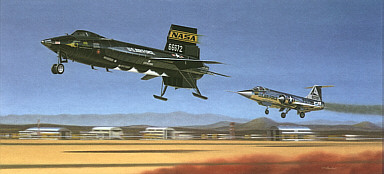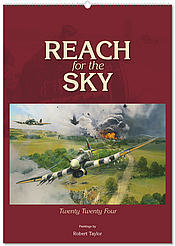First Re-Entry
North American X-15 Landing with F-104 Chase Plane
Description
This aviation art print by Mike Machat commemorates an event at Ten-thirty AM, Tuesday, June 29, 1965, Edwards Air Force Base, California. Two small dark specks appear on the distant horizon, descending rapidly over the eastern edge of Rogers Dry Lake, one trailing a smokey exhaust, the other powerless, gliding down like a rock. On the shimmering lakebed, the ground crew lights a red smoke grenade to indicate wind direction. As the specks grow larger, one emerges into a Lockheed F-104 Starfighter, the other a jet - black, dart-like experimental aircraft built by North American Aviation Corporation. It is the X-15, a mantis-shaped missile with its dual nosewheels and main landing skids extended scant seconds before it approaches the surface of the lakebed at a blistering speed of nearly 300 mph! As the exotic black rocketplane gently touches down on Runway 18, the research program's 138th mission comes to an end, and its 32-year old pilot enters the history books as the youngest ever to qualify as an astronaut.
Air Force Captain Joe H. Engle earned that distinction by flying the third of three X-15s built, S/N 56-6672, to an altitude of 280,600 feet, more than fifty miles above the earth's surface in what officially qualifies as outer space. Although U.S. manned spaceflights had been underway for four years with the Mercury and Gemini orbital programs, only 3 other pilots had flown North America's winged missile into the far reaches of space. By the end of the X-15 program in 1968, 5 more pilots would join the exclusive rank of men becoming astronauts in a winged aircraft!
Joe Engle became the eighth pilot to fly the X-15 on October 7, 1963, reaching Mach 4.21 and 77,000 feet on his first flight. He flew phases VII and VIII of the test program, focusing on high-speed stability and control, and scientific experimentation with a variety of cameras and data packages carried aloft. His first flight above 100,000 ft. occurred January 8, 1964 with a mission to evaluate stability augmentation systems, and was also Joe's first flight faster than Mach 5. Subsequent missions included tests for wingtip pods, heat transfer systems, and the ablative material later used on the X-15A-2 plus numerous tests for advanced re-entry techniques. He reached a top speed of Mach 5.71 (3,888 mph), and achieved a maximum altitude of 280,600 feet on his fourteenth flight, the landing of which is depicted in this image. Although his l6th and final X-15 flight occurred on October 14, 1965, Joe still considers the X-15 his all-time favorite airplane of the more than 180 different types he’s flown to date.
The program’s ultimate altitude record of 354,200 feet was set by NASA Chief X-15 pilot, Joe Walker, on Aug. 22, 1963, and the aircraft's ultimate speed of Mach 6.7 (4,520 mph!) was reached on Oct. 3, 1967 by Air Force Maj. William J. "Pete" Knight in an advanced version of the craft known as the X-15A-2. By the end of its 199-flight test program, the X-15 had become the most successful research aircraft ever flown, proving the concept of manned, rocketboosted exo-atmospheric flight, and paving the way for precision re-entry from space to a pre-determined landing site, a concept used routinely for nearly 100 Space Shuttle missions flown since 1981
Air Force Captain Joe H. Engle earned that distinction by flying the third of three X-15s built, S/N 56-6672, to an altitude of 280,600 feet, more than fifty miles above the earth's surface in what officially qualifies as outer space. Although U.S. manned spaceflights had been underway for four years with the Mercury and Gemini orbital programs, only 3 other pilots had flown North America's winged missile into the far reaches of space. By the end of the X-15 program in 1968, 5 more pilots would join the exclusive rank of men becoming astronauts in a winged aircraft!
Joe Engle became the eighth pilot to fly the X-15 on October 7, 1963, reaching Mach 4.21 and 77,000 feet on his first flight. He flew phases VII and VIII of the test program, focusing on high-speed stability and control, and scientific experimentation with a variety of cameras and data packages carried aloft. His first flight above 100,000 ft. occurred January 8, 1964 with a mission to evaluate stability augmentation systems, and was also Joe's first flight faster than Mach 5. Subsequent missions included tests for wingtip pods, heat transfer systems, and the ablative material later used on the X-15A-2 plus numerous tests for advanced re-entry techniques. He reached a top speed of Mach 5.71 (3,888 mph), and achieved a maximum altitude of 280,600 feet on his fourteenth flight, the landing of which is depicted in this image. Although his l6th and final X-15 flight occurred on October 14, 1965, Joe still considers the X-15 his all-time favorite airplane of the more than 180 different types he’s flown to date.
The program’s ultimate altitude record of 354,200 feet was set by NASA Chief X-15 pilot, Joe Walker, on Aug. 22, 1963, and the aircraft's ultimate speed of Mach 6.7 (4,520 mph!) was reached on Oct. 3, 1967 by Air Force Maj. William J. "Pete" Knight in an advanced version of the craft known as the X-15A-2. By the end of its 199-flight test program, the X-15 had become the most successful research aircraft ever flown, proving the concept of manned, rocketboosted exo-atmospheric flight, and paving the way for precision re-entry from space to a pre-determined landing site, a concept used routinely for nearly 100 Space Shuttle missions flown since 1981
Limited Edition
- 850 numbered, personally autographed by Maj. Gen. Joe H. Engle and the Artist
Overall Height ca.
52
cm
Image Height ca.
33
cm
Overall Width ca.
85
cm
Image Width ca.
68
cm







